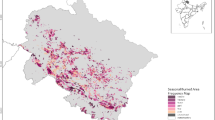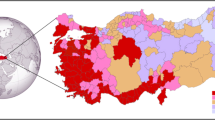Abstract
Forest fires are influenced by several factors, including forest location, species type, age and density, date of fire occurrence, temperatures, and wind speeds, among others. This study investigates the quantitative effects of these factors on the degree of forest fire disaster using nonparametric statistical methods to provide a theoretical basis and data support for forest fire management. Data on forest fire damage from 1969 to 2013 was analyzed. The results indicate that different forest locations and types, fire occurrence dates, temperatures, and wind speeds were statistically significant. The eastern regions of the study area experienced the highest fire occurrence, accounting for 85.0% of the total number of fires as well as the largest average forested area burned. April, May, and October had more frequent fires than other months, accounting for 78.9%, while September had the most extensive forested area burned (63.08 ha) and burnt area (106.34 ha). Hardwood mixed forest and oak forest had more frequent fires, accounting for 31.9% and 26.0%, respectively. Hardwood-conifer mixed forest had the most forested area burned (50.18 ha) and burnt area (65.09 ha). Temperatures, wind speeds, and their interaction had significant impacts on forested area burned and area burnt.

Similar content being viewed by others
References
Archibald S, Lehmann CER, Gómez-Dans JL, Bradstock RA (2013) Defining pyromes and global syndromes of fire regimes. Proc Natl Acad Sci USA 110:6442–6447
Bowman DMJS, Balch JK, Artaxo P, Bond WJ, Carson JM, Cochrane MA, D’Antonio CM, DeFries RS, Doyle JC, Harrison SP, Johnston FH, Keeley JE, Krawchuk MA, Kull CA, Marston JB, Moritz MA, Prentice IC, Roos CI, Scott AC, Swetnam TW, Werf GR, Pyne SJ (2009) Fire in the earth system. Science 324:481–484
Brown MB, Forsythe AB (1974) Robust tests for the equality of variances. J Am Stat Assoc 69:364–367
Calvin D (2011) Choosing and using statistics: a biologist’s guide, 3rd edn. Wiley, Hoboken, pp 175–177
Chas-Amil ML, Prestemon JP, McClean CJ, Touza J (2015) Human-ignited wildfire patterns and responses to policy shifts. Appl Geogr 56:164–176
Duff PA, Walsh JE, Graham JM, Mann DH, Rupp TS (2005) Impacts of large-scale atmospheric-ocean variability on Alaskan fire season severity. Ecol Appl 15:1317–1330
Feng M (2005) The teacher gives one-way analysis of variance of influence degree on the teaching quality. Math Pract Theory 35:59–64
Flannigan MD, Logan KA, Amiro BD, Skinner WR, Stocks BJ (2005) Future area burned in Canada. Clim Change 72:1–16
Girardin MP, Ali AA, Carcaillet C, Gauthier S, Hély C, Goff HL, Terrier A, Bergeron Y (2013) Fire in managed forests of eastern Canada: risks and options. For Ecol Manag 294:238–249
Guo FT, Wang GY, Innes JL, Ma XQ, Sun L, Hu HQ (2015) Gamma generalized linear model to investigate the effects of climate variables on the area burned by forest fire in northeast China. J For Res 26:545–555
Hantson S, Pueyo S, Chuvieco E (2016) Global fire size distribution: from power law to log-normal. Int J Wildland Fire 25:403–412
John HM (2008) Handbook of biological statistics. Sparky House Publishing Baltimore, Maryland, p 173
Kou XJ, Baker WL (2006) Accurate estimation of mean fire interval for managing fire. Int J Wildland Fire 15:489–495
Krawchuk MA, Moritz MA, Parisien M-A, Van Dorn J, Hayhoe K (2009) Global pyrogeography: the current and future distribution of wildfire. PLoS ONE 4:e5102
Li J, Shan YL, Yu SX, Zhang ZZ (2017) Influencing factors of extremely large forest fires in Jilin Province with nonparametric test methods. J Northeast For Univ 45:61–64
Marlier ME, DeFries RS, Voulgarakis A, Kinney PL, Randerson JT, Shindell DT, Chen Y, Faluvegi G (2012) El Niño and health risks from landscape fire emissions in Southeast Asia. Nat Clim Change 3:131–136
Marlon JR, Bartlein PJ, Carcaillet C, Gavin DG, Harrison SP, Higuera PE, Joos F, Power MJ, Prentice IC (2008) Climate and human influences on global biomass burning over the past two millennia. Nat Geosci 1:697–702
McCoy VM, Burn CR (2005) Potential alteration by climate change of the forest-fire regime in the boreal forest of central Yukon territory. Arctic 58:276–285
NIFC (Naitional Interagency Fire Center) (2004) Urban-wildland and wildland fire statistics. National Interagency Fire Center, Boise
O’Brien RG (1979) A general ANOVA method for robust tests of additive models for variances. J Am Stat Assoc 74:877–880
Pan XP, Ni ZZ, Yin F (2002) A robust method for homogeneity of variance. Mod Prev Med 29:774–776
Roth AJ (1983) Robust trend tests derived and simulated: analogs of the Welch and Brown Forsythe tests. J Am Stat Assoc 78:972–980
Scheirer CJ, Ray WS, Hare N (1976) The analysis of ranked date derived from completely randomized factorial designs. Biometrics 32:429–434
Shan YL, Zhang J (2009) Estimation of carbon emission from forest fires in Jilin Province from 1969 to 2014. Sci Silv Sin 45:84–89
Shan YL, Sun PY, Guan S, Sun JS, Zhang YW (2014) Applying Canadian forest fire weather index system in Jilin Province. J Northeast For Univ 42:134–136
Shan YL, Wang YH, Flannigan M, Tang SY, Sun PY, Du FG (2017) Spatiotemporal variation in forest fire danger from 1996 to 2010 in Jilin Province, China. J For Res 28:983–996
Shen XP, Qi HP, Liu XN, Ren XW, Li JS (2013) Realization of two factor nonparametric ANOVA in SPSS. Chin J Health Stat 30:913–914
Shu LF, Tian XR, Li H (1998) Status of international forest fire in last decade. World For Res 11:41–47
Sokal RR, Rohlf FJ (1995) Biometry: the principles and practice of statistics in biological research. WH Freeman and Company, New York
Spiller SA, Fitzsimons GJ, Lynch JR, John G, McClelland GH (2013) Spotlights, floodlights, and the magic number zero: Simple effects tests in moderated regression. J Mark Res 50:277–288
Streets DG, Yarber KF, Woo JH, Carmichael GR (2003) Biomass burning in Asia: annual and seasonal estimates and atmospheric emissions. Global Biogeochem Cycles 17:1099
Sun YQ (2003) Research on the developmental mode of forest fire prevention system in Jilin Province. For Fire Prev 21:16–19
Tian XR, Shu LF, Zhao FJ, Wang MY, Douglas JM (2011) Future impacts of climate change on forest fire danger in northeastern China. J For Res 22:437–446
Toothaker LE, Chang HS (1980) On “the analysis of ranked date derived from completely randomized factorial designs”. J Educ Behav Stat 5:169–176
Westerling AL, Turner MG, Smithwick EAH, Romme WH, Ryan MG (2011) Continued warming could transform Greater Yellowstone fire regimes by mid-21st century. Proc Natl Acad Sci USA 108:13165–13170
Zhou X, Zhang Y (2014) Statistical analysis of forest fire risk in China. Stat Inf Forum 29:34–39
Zou QC, Di XY, Yang G (2010) Evaluation on forest fire suppression capacity in Jilin Province. J Northeast For Univ 38:63–65
Acknowledgments
This study was supported financially by the National Key Research and Development Plan (2018YFD0600205), China’s National Foundation of Natural Sciences (31470497), and the Project of Jilin Province Department of Education (JJKH20180347KJ).
Author information
Authors and Affiliations
Corresponding authors
Additional information
Publisher's Note
Springer Nature remains neutral with regard to jurisdictional claims in published maps and institutional affiliations.
Project funding: This study was supported financially by the National Key Research and Development Plan (2018YFD0600205), China’s National Foundation of Natural Sciences (31470497), and the Project of Jilin Province Department of Education (JJKH20180347KJ).
The online version is available at http://www.springerlink.com
Corresponding editor: Chai Ruihai
Rights and permissions
About this article
Cite this article
Li, J., Shan, Y., Yin, S. et al. Nonparametric multivariate analysis of variance for affecting factors on the extent of forest fire damage in Jilin Province, China. J. For. Res. 30, 2185–2197 (2019). https://doi.org/10.1007/s11676-019-00958-1
Received:
Accepted:
Published:
Issue Date:
DOI: https://doi.org/10.1007/s11676-019-00958-1




